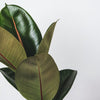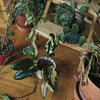Houseplants harmless to pets

They say that the Czechs are a nation of dog walkers. There are said to be over 2.5 million dogs living in the Czech Republic, and during the covid pandemic the numbers have certainly increased. However, the number of households also increased, which also increased in terms of the number of roommates. But that brings with it the question - will our pet pets get along with our potted pets? If you still don't know if your maids are pet-friendly or not, you've come to the right place. But even if they are poisonous, you certainly don't have to throw them away. It's enough if you place them somewhere where your pet can't reach them and you try to avoid possible nibbling.
Fortunately, there is a large group of plants that are not poisonous to pets or children/humans, and some are even suitable for feeding rodents or rabbits. Want to know more? Read on!
You don't have to worry with these
Below is an overview of plants that are safe for pets. However, it is true that they should not arrange the whole plant for sitting, we think it is rather harmless to eat a few leaves. The content of possible toxins in the plant does not exceed the normally established standards for vegetables, also intended for human consumption.
Hoya
These succulent-type plants are decorated with shiny fleshy leaves that can hold water for quite a long time. For this reason, they are also suitable for beginners, who can be pleased by the fact that they grow relatively quickly and, with good care, form beautiful fragrant inflorescences.
Tested. Not so long ago, our rabbit Poo bit off three leaves of my Hoya carnosa, which I accidentally left on the table while watering and its stems reached the ground. Apart from the fact that I was angry with him, nothing happened to him, and luckily poor Hoya didn't experience anything dramatic either. - Baby girl

Photo: Be especially careful with cacti that have spines. Many cacti contain poisonous substances and can cause very unpleasant skin inflammations.
Calathea & Marantha
These plants are also known as praying mantises . They got their name because in the evening they straighten their leaves upwards, thus resembling hands folded in prayer. They are beautifully colored species that love higher air humidity and a slightly moist substrate. A location in moderate partial shade is suitable for them, certainly not in direct burning sun. Their leaves are delicate and would burn easily.
Peperomia
This very numerous and species-diverse genus is also non-toxic to humans and animals. Care for it depends on the specific species, but it is usually true that they will thrive in a sunny location, often in direct sunlight, and they do not require high humidity or frequent watering.
African violet
These popular flowering indoor plants will also delight children in the children's room. It is available in many different colors and is very easy to care for. Just place the violet in a place where it will have enough diffused light and water it once in a while. Tolerates drought rather than waterlogging. And you don't have to worry even if you have pets - it's not poisonous to them either.
 Photo: Cat nibbling on Asparagus
Photo: Cat nibbling on Asparagus
Some ferns
Ferns are a large group of plants, including poisonous species, especially garden and forest ones. But if you are going to grow, for example, the very popular Nephrolepis at home, it ranks among the non-poisonous plants. As well as Asparagus , Phlebodium ,Asplenium or Platycerium.
Palm trees
Indoor palm trees mainly attract cats with their appearance. Both for nibbling and larger species for climbing. Fortunately, these plants are not poisonous, so if your cat bites a leaf here and there, nothing should happen to her. Non-poisonous species include Areca lutescens , Chamaedorea elegans and also Nolina (elephant's foot).
Tillandsia
These air plants are also harmless to pets. Although such a ropelike tillandsia, or Tillandsia usneoides , can be quite attractive especially for cats and they might try to nibble on it. However, it should not harm the animal even when swallowed.
Catnip, cat grass
Cyperus zumula, or cat grass, is a great plant especially for cats, as the name suggests. It is an unpretentious room plant with long, fresh green leaves that are thin, drooping, or slightly curled. It likes plenty of indirect light and abundant watering. Cats and dogs like to enjoy it, it helps them digest food better, it is also suitable for rabbits, guinea pigs or turtles. If you have such animals at home and you want to treat them to nibbling once in a while, get more of these plants right away so that their leaves can grow.
Green plant (Chlorophytum)
Another plant that delights rabbits and guinea pigs in particular is sedge. The plant itself is very decorative, and if it also serves as pet food once in a while, that's just a nice bonus. But what more! According to NASA research, the green plant cleans the air of pollutants and is recommended for households with allergies or chronic lung diseases. There are several varieties - for example, Chlorophytum variegatum , which has long pointed white-edged leaves and is therefore probably the most suitable for feeding; Chlorophytum Bonnie , which has similarly colored leaves, but they are curled; andChlorophytum Fire Flash , which has lance-shaped leaves and bright orange petioles, is also available on our e-shop.
Callisia (Callisia repens)
Kalisia is not poisonous to animals or humans. On the contrary, it is also used as a medicinal plant. In the countries of South America, where it comes from, it grows in the lower levels of tropical forests, where it cannot be exposed to direct sunlight, but where there is warmth and high humidity. Such conditions can often be replaced by cultivation in terrariums, e.g. for reptiles and turtles. Even home-bred birds like to enjoy it.

Photo: Sometimes you have to think not only about poisonous-non-poisonous, but also about the appropriate placement of plants in the apartment. We don't want a falling flower pot to injure our pet or small child.
Other non-poisonous plants
Other plants that are non-poisonous for animals include begonias, crassula, dracaena (opinions are quite different here) or tradescantia. We have dedicated an entire section to these plants in our e-shop to make it easier for you to find and choose. You can easily recognize it by the label with a paw, which is placed on the photo of the plant.
Or you can find them all together HERE .
Plants and cats
Cats are generally very curious and lively animals, which are not easy to tame and prevent them from climbing tall houseplants and nibbling on their leaves. But of course it depends on the nature of each individual cat. But the easiest will certainly be if we try to place the plants out of their reach or if we limit the cultivation of some very toxic houseplants. You can read about which they are in this article of ours.
In general, cats are most likely to nibble on plants with long, thin leaves that remind them of grass. Outdoor cats eat here for better digestion. For example, try to get your cat cat grass, or Cyperus zumula , which could draw all the attention to itself and the cat could nibble on it at will.
There is also a tradition that cats repel citrus, you can try placing their peels in a clay pot. In pet supply stores, you will also definitely find special sprays that also repel cats, which you can try spraying your plants with.
We don't have to be as careful when growing house plants and breeding dogs, rabbits or small rodents as when breeding cats. It will be enough if you place the plants out of their reach and nothing should happen. For example, hanging macramés are great for this, or you can place the plants directly on the wall using, for example, this holder.
If you didn't find your houseplant in this list or you're still not sure if it's poisonous or not, don't be afraid to write to us for advice!
We wish you a pleasant and peaceful coexistence of your plants and animals.
Car: Ing. Elizabeth Lacinová
-
Posted in
Zajímavosti a tipy




